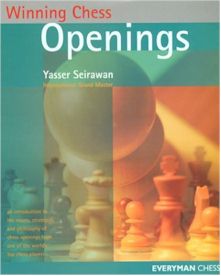Winning Chess Openings 
 An Easytorecall Book Review
An Easytorecall Book Review
Winning Chess: Openings
By GM Yasser Seirawan with Jeremy Silman Everyman Publishers 2003
257 pages (July 15, 2003)
£10.49
Book Review
by Graham Brown
THE first four books of the excellent 'Winning Chess' series have been reprinted many times. This, is a 5th, shiny new first edition, to add to the collection.
As usual, the text is infused with the 4 principles of Book 1. But this is about the Openings so they are less apparent until the gentle surprise ending. The book starts, sportingly, with some very early Seriawan games. I am sure that later titled opponents would have been happy to see him play the move 1. d3, then set off on a plan to ape all their moves, and be checkmated on move 4. I must confess at this point I was suspicious that this convenient miniature mirror game had been composed!! But Seirawan continues 'Today I can only stare at this position with open mouthed horror. White isn't checkmated at all!'
Several more early Seirawan efforts follow with plenty more lessons to be learnt. The way the opening 'innovations' of the young Seirawan are continually neatly refuted by the experienced players at the 'last exit coffeehouse' is instructive. These lessons are then written out clearly, so that the beginner can see why the author is lecturing them – the principals have been gleaned after painful defeats! His aim is not to preach but to save us time and pain.
Then the book gets more formal, and classical kings and queens pawn openings are dealt with. All the main openings are covered. Then we get modern king and queen pawn defences such as The Scandinavian and the French defence. You don't get pages on each, but you get a good overview of all the openings. I think Seirawan is remembering how he learnt, 'when my teachers took me through the classical openings, they didn't whip through the first dozen moves and proudly state, 'so that, Yasser, is the Queen's Gambit Declined!' On the contrary, they encouraged me to question every move, including the first one. I wasn't being asked to memorise an opening; I was taught to understand the logic of the move.'
The last Chapter was quite surprising to me but bearing in mind the above maybe I shouldn't have been. It is the key Chapter, and what Seirawan most wants to tell us about 'Winning Openings'. I suppose my surprise is because the conclusion he reaches about what he will recommend to us as an opening repertoire is something you normally hear from people who haven't learnt many traditional openings. Since this is the key to the book I will quote the whole first paragraph.
'Understanding the information presented in the previous chapters took me several years. Learning all the classical openings and defences and their names was a real beer. It did, however, help me to appreciate that I'd never return to my Cannon or Queen Raid Openings! My favourite opening move became 1.e4, and it would have stayed that way forever except for one small problem: I lost.' As soon as he had found a line to deal with the Dragon ... 'I lost because I wasn't aware of the latest wrinkle in the Scheveningen Keres Attack.' Seirawan also felt he was playing less and less 'original' chess in his games. So how to escape the 'book'?. Doesn't 'book' prescribe the best set of opening moves to get a decent middle game? He gives a big no to this explaining that there is no single best opening or defence.
The answer came from his battles with the Sicilian. From leaving his king too exposed when trying to slay 'the dragon.' he noticed his own king was constantly left unprotected' and that the g7 bishop put great pressure on the long diagonal AND was a great defender. It still took him a long time to give up 1. e4, but when he did his new order would be the 'Barcza' opening. Against nearly every response White's first 4 moves are the same ... Nf3, g3, Bg2, 0-0.
'My joy for chess was rekindled after I started to play the Barcza Opening, no longer did I have to know the latest wrinkle of the Ruy Lopez. I could now try to outplay my opponent with both of us playing our own moves.' Seirawan goes on to say that every World Champion has played the Barcza at some time in their careers! Then we are given strategies against Black's different ideas. And next Seriawan says that he was so attracted to the Barcza as White that he tried it with Black against d4. Whilst this involves a discussion of the KID this is at least only one opening to learn rather than the miriad expert systems that Seirawan (and you!) will face after 1. e4. Then he does the same against 1. d4. We end up with the Barcza, KID and the Pirc to learn.
I like this book, even though it doesn't throw enough opening theory away for my taste! But as a Christmas present for a beginner I think it hits just the right balance between relying too much on opening theory and rejecting it completely. But above all - it explains the ideas behind the openings to enable the reader to build their own Winning Openings.
This review was first published in Chess Today CT-1082.
Graham Brown is a Freelance Journalist, technical editor of Chess Today and co-author of the Batsford book Chess on the Web
Can't find it?
Try our search engines, price comparison and online auction pages.

